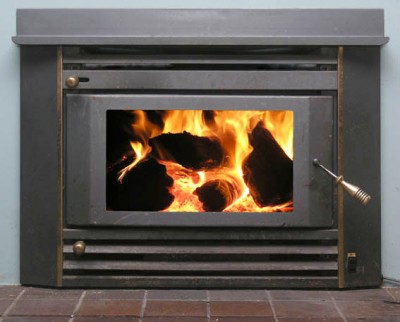Wood heaters may be more sustainable than we think — but that depends on how the wood was obtained. [15 July 2008 | Peter Boyer]
There are some strange twists and turns in the science of carbon emissions, and one of the strangest is as close as the fire in your living room.

Don't throw out the wood heater, just yet.
You see wood burning to charcoal and ash, sending smoke up the chimney and out into the cold winter air. It’s obvious that your wood fire is adding carbon to our atmosphere.
So you get rid of the wood heater and find another way of keeping your home warm, like a gas heater, or better, an electric heat pump drawing on Tasmania’s clean hydro power. Right?
Well, perhaps not, if we’re to believe scientists from the CSIRO’s Forestry and Forest Products Division. Or the Firewood Association of Australia, which asks us to believe that using firewood can help reduce greenhouse gas emissions.
In comparing emissions from firewood used in home heating with other forms of heating, CSIRO scientists looked at factors like firewood source (plantation, woodland or dense forest), tree regeneration, heating efficiency and transport.
Their finding was that allowing for forest regeneration, the carbon footprint of firewood taken from lightly-forested land, or woodland, was only a tenth that of coal-fired electricity – so long as the resource was renewed by re-forestation.
Hydro electricity should give electricity a substantial edge over firewood here, but low dam storage levels have forced increasing imports of Victorian coal-fired power – currently around 30 per cent of the total. But adjusting the CSIRO figures accordingly, the carbon footprint of Tasmanian wood fires would still be only a third that for electrical heating.
Part of this advantage over coal-fired power comes from the fact that heat is produced directly from combustion, instead of indirectly from burning coal to make electricity which then has to be transmitted over a distance to homes.
This isn’t the end of the story. Firewood isn’t equal: native woodland firewood, for instance, has a higher carbon footprint than that from plantations. A national voluntary code of practice for firewood merchants promotes “harvesting operations in plantations and sustainably managed native forests, or from residue from manufacturing processes or salvage operations”.
What’s more, collection of firewood can deprive forests of animal homes in dead tree hollows and organic matter from rotting wood – essential for a forest’s future well-being. The code of practice says that firewood must be sourced “in accordance with sustainable management principles to protect biodiversity and ecosystem processes”.
A study of Australian firewood use has found that 84 per cent of household firewood is collected from private property, which makes it very hard to ensure our firewood supply is sustainable.
Consumers can help modify behaviour by seeking to find out where firewood has come from and how it was obtained, but a sustainable firewood industry won’t happen without more rigorously-enforced formal regulation. Once again, we need government to act.
